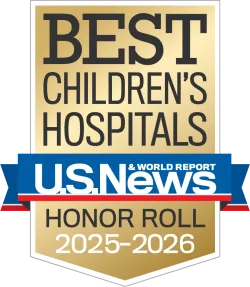Breadcrumb
- Home
- Programs & Services
- Oculoplastics
Comprehensive care for oculoplastics conditions
Oculoplastics diagnoses and treats eyelid, eye socket, orbit, and tear duct conditions in patients of all ages — from infants to adults. We treat the full range of oculoplastic conditions, including congenital ptosis (droopy eyelids), orbital (eye socket) conditions, congenital tear duct anomalies, complex orbitofacial trauma reconstruction, and more.
As one of the only programs in the country with designated specialists in pediatric oculoplastic surgery, we regularly care for children with rare and complex conditions. Our program combines advanced diagnostic tools, innovative surgical techniques, and close collaboration with leading experts across disciplines to ensure the best possible outcomes. By combining specialized expertise with state-of-the-art technology and child-centered treatment plans, we offer exceptional care for every patient. Our close working relationship with the specialized pediatric ophthalmologists in our department allows us to develop treatment plans that maximize both eye function and vision outcomes as well as appearance and facial harmony.
How we approach oculoplastic surgery
Treating pediatric eye and facial conditions requires a specialized approach because children are still developing. Factors like a child’s age, stage of visual development, and the growth of the bones in their face and skull all inform the way their condition is managed. Conditions that are present at birth often have different causes and anatomy than those that develop later in life. Because of these differences, problems involving the eyelids or eye sockets in children often need to be treated differently than in adults. Oculoplastic surgeons who specialize in pediatric care are trained to recognize these nuances and provide appropriate treatment that is tailored towards young patients.
As one of the leading centers in the country for pediatric oculoplastic surgery, we perform a high volume of these procedures — so every child we treat benefits from the experience and skill of our specialized providers.
We follow a child-centered model of care, looking beyond each child’s condition to understand their unique medical, developmental, and emotional needs. We also work closely with families to create personalized care plans for every child, offering guidance and support every step of the way.
Our approach includes:
- Collaboration across specialties. Our seamless coordination with specialists from multiple disciplines helps us provide comprehensive, personalized care that is tailored to each patient’s unique needs. Our surgeons frequently team up with other specialists at Boston Children’s to treat tumors or congenital deformities that affect a child’s entire face.
- Dedicated, patient-centered care. We prioritize each patient’s well-being by taking the time needed to fully understand their condition and provide thoughtful, individualized treatment.
- Access to leading specialists. Our highly experienced pediatric oculoplastic surgeons are known nationally for handling the most difficult cases. They are also among the most experienced in the country, performing a high volume of procedures each year.
- A child-friendly environment. Our teams are specifically trained to treat children, ensuring their safety and comfort.
- Supportive services. Some children require support that extends beyond their surgical treatment. Our department’s dedicated social worker is available to help children and their families by ensuring their emotional and social needs are being met as part of their overall care.
Our services
Oculoplastics offers comprehensive evaluations and treatments for a variety of conditions affecting the area surrounding the eyes. Our specialized services include:
- Eyelid surgery – We treat congenital and acquired eyelid conditions, including congenital ptosis or other eyelid defects, eyelid malposition, and trauma-related injuries. Our advanced techniques include frontalis flap surgery for ptosis and reconstructive surgery for complex injuries or congenital anomalies.
- Tear duct surgery – We manage congenital and acquired tear duct obstructions and related infections. Our team uses innovative techniques such as endoscopic dacryocystorhinostomy (DCR), a minimally invasive procedure that restores tear drainage reducing scarring and recovery time.
- Orbital (eye socket) surgery – Our specialists treat orbital tumors, trauma, congenital orbitofacial syndromes, and structural anomalies using cutting-edge technology involving custom-made patient-specific implants, and minimally invasive techniques such as transorbital skull base surgery (TONES) to treat conditions through the eye socket rather than cutting the whole skull open.
- Reconstructive surgery – We perform comprehensive reconstruction after trauma, tumor removal, or congenital deformities, often collaborating with plastic surgeons, neurosurgeons, otolaryngologists, and craniofacial specialists to restore both function and appearance.
- Corneal neurotization surgery – We utilize this innovative surgical procedure that restores sensation to the surface of the eye (cornea) in patients who have lost corneal innervation due to injury, surgery, or disease. This procedure takes a healthy nerve and connects it to the eye to bring back sensation over time, which can promote healing of the eye and protect it from further infection, dryness, or injury.
- Hemangioma treatment – We provide expert care for infantile hemangiomas, vascular malformations, and periocular tumors, working alongside the Vascular Anomalies Center and the Dana Farber/Boston Children’s Cancer and Blood Disorders Center to ensure cutting-edge treatment and multidisciplinary coordination.
Preparing for your first visit
In order to ensure a comprehensive evaluation and dedicated care, we ask that you please provide us with the following prior to your child’s appointment:
- Copies of your child’s records from any previous eye doctor’s appointments, e.g. any visits to the ophthalmologist or optometrist.
- Surgical reports from any prior surgeries your child has had for their condition. You can also contact your child’s doctor and ask them to send the surgical report to us.
- Images from any CT scans or MRIs your child has had for their condition. These may be sent through electronically from the outside facility, or you may bring a copy of the disc.
Our areas of innovation
Our program is committed to advancing oculoplastic surgery through ongoing research and clinical innovations. Some of our key areas of innovation include:
- The use of minimally invasive surgical approaches for eyelid and orbital procedures, including frontalis flap surgery for ptosis, TONES for treatment of skull base lesions, and corneal neurotization to restore sensation to the eye.
- Large-scale data collection on lacrimal, eyelid, and orbital conditions to improve treatment strategies.
- Congenital orbital fibrosis research led by Elizabeth Engle, MD, focused on understanding the genetic causes of ptosis and related conditions.

